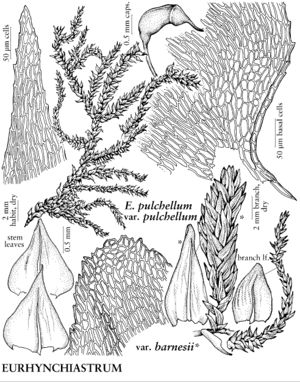Eurhynchiastrum
Arctoa 11: 260. 2003.
| Taxon | Illustrator ⠉ | |
|---|---|---|
 | Eurhynchiastrum pulchellum | Patricia M. Eckel |
Plants small to medium-sized, in loose to dense mats or tufts, green or yellowish to brownish. Stems creeping to arching, loosely to densely terete-foliate, irregularly densely branched, branches more densely foliate at their apices; central strand present; pseudoparaphyllia with apex acute; axillary hairs of 3 or 4 cells. Stem-leaves erect to erectopatent, loosely to closely imbricate or somewhat spaced, broadly ovate-triangular to ovatelanceolate, slightly concave, not plicate, or plicate in large plants; base narrowly decurrent; margins serrulate to subentire; apex gradually tapered or broadly acuminate, rarely blunt; costa to 60–85% leaf length, strong, terminal spine present; alar cells isodiametric, broader than laminal cells; laminal cells linear; basal juxtacostal cells slightly shorter, not clearly differentiated from laminal cells. Branch leaves smaller, narrower; apex blunt. Sexual condition phyllodioicous or dioicous; perichaetial leaves reflexed, apex gradually acuminate. Seta redbrown, smooth or rarely very slightly rough at places. Capsule inclined to horizontal, redbrown, oblong, slightly curved dorsally; annulus separating by fragments; operculum rostrate; peristome xerocastique, perfect. Calyptra naked. Spores 12–17 µm.
Distribution
North America, Mexico, Central America, Eurasia, Africa, Atlantic Islands, widespread throughout temperate, boreal, Arctic and alpine regions
Discussion
Species 1.
Eurhynchiastrum was segregated from the polyphyletic Eurhynchium (M. S. Ignatov and S. Huttunen 2002), where it was placed by most authors. Other authors, such as G. De Notaris (1867), H. Robinson (1987), and K. D. McFarland (1994b), accepted its placement in Rhynchostegium. North American species of Rhynchostegium differ from Eurhynchiastrum in their robust habit and lack of an abaxial spine at the end of the costa. In the present concept, Eurhynchium is strictly a Palearctic genus.
Selected References
None.
Lower Taxa
"long" is not a number."broad" is not a number.